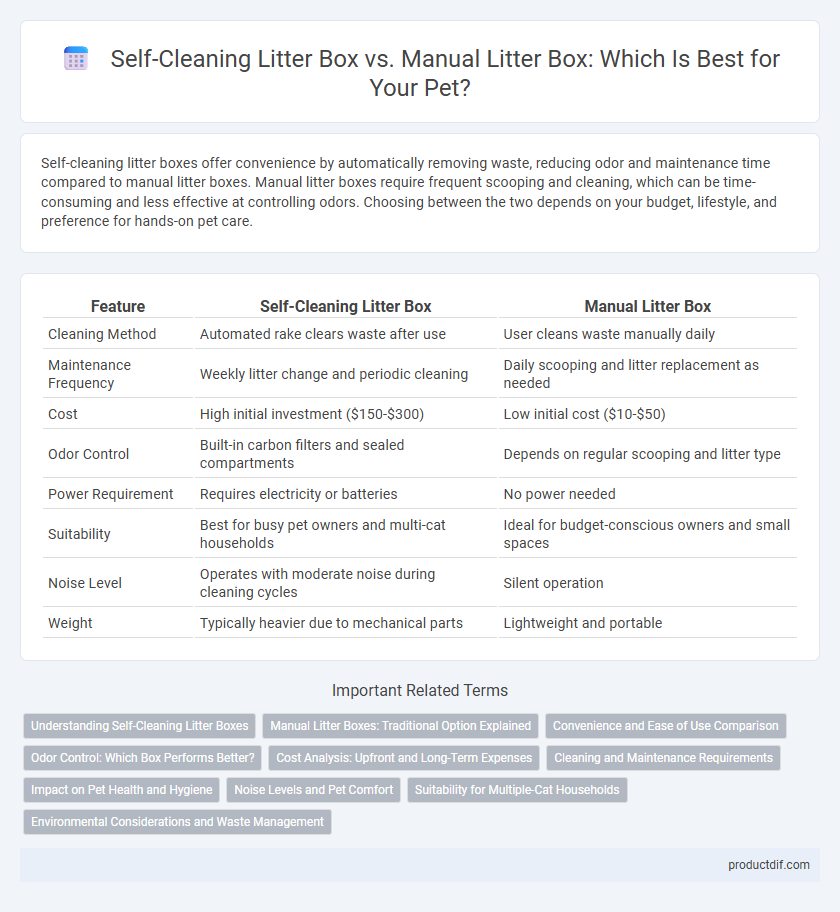Self-cleaning litter boxes offer convenience by automatically removing waste, reducing odor and maintenance time compared to manual litter boxes. Manual litter boxes require frequent scooping and cleaning, which can be time-consuming and less effective at controlling odors. Choosing between the two depends on your budget, lifestyle, and preference for hands-on pet care.
Table of Comparison
| Feature | Self-Cleaning Litter Box | Manual Litter Box |
|---|---|---|
| Cleaning Method | Automated rake clears waste after use | User cleans waste manually daily |
| Maintenance Frequency | Weekly litter change and periodic cleaning | Daily scooping and litter replacement as needed |
| Cost | High initial investment ($150-$300) | Low initial cost ($10-$50) |
| Odor Control | Built-in carbon filters and sealed compartments | Depends on regular scooping and litter type |
| Power Requirement | Requires electricity or batteries | No power needed |
| Suitability | Best for busy pet owners and multi-cat households | Ideal for budget-conscious owners and small spaces |
| Noise Level | Operates with moderate noise during cleaning cycles | Silent operation |
| Weight | Typically heavier due to mechanical parts | Lightweight and portable |
Understanding Self-Cleaning Litter Boxes
Self-cleaning litter boxes use automated mechanisms to sift and separate waste, significantly reducing odor and cleaning time compared to manual litter boxes. Equipped with sensors and timers, these devices activate disposal cycles only when the cat exits, providing a hygienic environment with minimal human intervention. Despite higher upfront costs, self-cleaning litter boxes enhance convenience and promote consistent litter maintenance, improving feline health and home cleanliness.
Manual Litter Boxes: Traditional Option Explained
Manual litter boxes remain a popular choice for pet owners due to their simplicity and affordability. These boxes require regular scooping and cleaning, which allows for close monitoring of a cat's health and waste habits. Unlike self-cleaning litter boxes, manual models have no mechanical parts, reducing maintenance and breakdown risks.
Convenience and Ease of Use Comparison
Self-cleaning litter boxes offer significant convenience by automating waste removal, reducing the frequency of manual scooping and minimizing odor. Manual litter boxes require daily maintenance, demanding more time and effort from pet owners to ensure cleanliness and hygiene. The ease of use of self-cleaning boxes caters to busy lifestyles, while manual boxes remain a cost-effective option but require consistent attention.
Odor Control: Which Box Performs Better?
Self-cleaning litter boxes outperform manual litter boxes in odor control by automatically removing waste shortly after use, reducing the time odors have to develop. Advanced filtration systems and sealed compartments further trap ammonia and other unpleasant smells, ensuring fresher air in the home. Manual litter boxes require frequent scooping and thorough cleaning to prevent odor buildup, making them less effective in maintaining a consistently odor-free environment.
Cost Analysis: Upfront and Long-Term Expenses
Self-cleaning litter boxes typically require a higher upfront investment, ranging from $150 to $500, compared to manual litter boxes which can cost as low as $20 to $40. Long-term expenses for self-cleaning models include replacement parts and specialized litter, potentially adding $15 to $30 monthly, while manual litter boxes incur mainly litter and occasional scoop replacements averaging $10 to $20 per month. Evaluating total costs, manual boxes remain more economical over time, but self-cleaning options offer convenience that may justify the higher expenditure for some pet owners.
Cleaning and Maintenance Requirements
Self-cleaning litter boxes reduce the frequency of daily scooping by automatically separating waste, minimizing odor and mess while requiring periodic emptying of waste compartments and occasional sensor maintenance. Manual litter boxes demand consistent daily scooping and thorough weekly cleaning to prevent bacterial buildup and odor. Automated systems can save time and effort but may require higher upfront costs and occasional technical troubleshooting compared to manual options.
Impact on Pet Health and Hygiene
Self-cleaning litter boxes reduce the risk of bacterial growth and ammonia buildup by automatically removing waste, promoting a cleaner environment that supports better respiratory health for cats. Manual litter boxes require frequent scooping to prevent odor and bacterial contamination, which, if neglected, can lead to urinary tract infections and other health issues in pets. Maintaining consistent litter hygiene directly impacts pets' comfort and overall well-being, making self-cleaning models a beneficial investment for proactive pet care.
Noise Levels and Pet Comfort
Self-cleaning litter boxes operate with automated mechanisms that produce noticeable noise, which may stress sensitive cats and affect their comfort during use. Manual litter boxes offer a silent environment, allowing pets to feel more relaxed and less disturbed while eliminating. Choosing a low-noise self-cleaning model can improve pet comfort by minimizing stress related to litter box sounds.
Suitability for Multiple-Cat Households
Self-cleaning litter boxes offer superior odor control and maintenance efficiency, making them highly suitable for multiple-cat households where frequent cleaning is essential to prevent unpleasant smells. Manual litter boxes require regular scooping, which can become time-consuming and less effective at managing waste in homes with several cats. Investing in an automatic litter box with features like high-capacity waste compartments and odor-sealing technology ensures a cleaner environment and reduces litter tracking for multi-cat families.
Environmental Considerations and Waste Management
Self-cleaning litter boxes reduce waste accumulation by automatically separating clumps, leading to less frequent disposal and decreased usage of disposable liners, conserving landfill space. Manual litter boxes often require daily scooping and full litter changes, resulting in higher litter consumption and increased plastic bag waste. Choosing eco-friendly litter options and proper waste disposal methods enhances environmental sustainability regardless of the litter box type.
Self-Cleaning Litter Box vs Manual Litter Box Infographic

 productdif.com
productdif.com